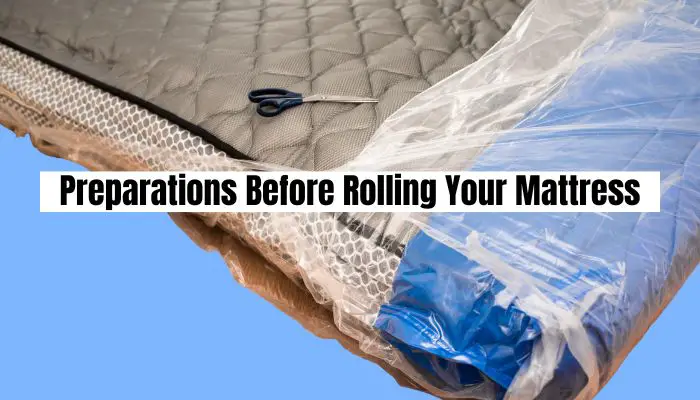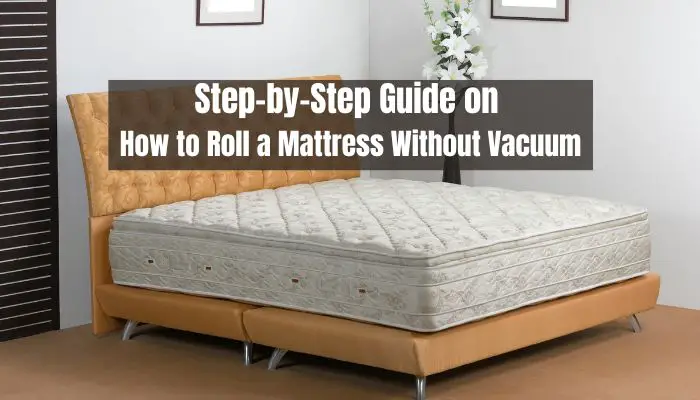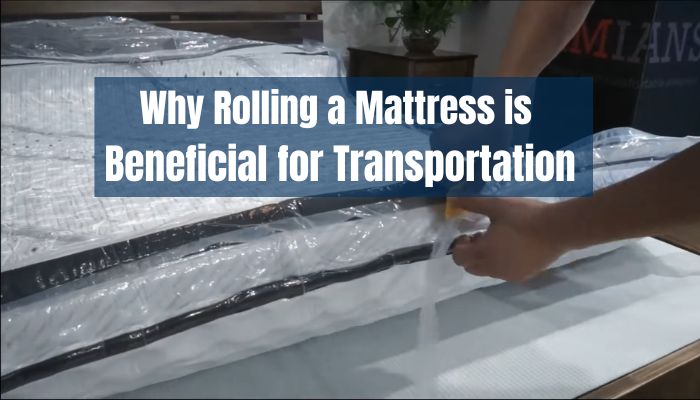Looking to transport your mattress but lack a vacuum? Discover our comprehensive guide on How to roll a mattress without vacuum! Find easy, practical steps that make the task a breeze.
Why Rolling a Mattress is Beneficial for Transportation
Transporting a mattress can be daunting due to its bulky size and weight. But imagine if there was a way to conveniently pack it, making it easily transportable. Enter the concept of mattress rolling. This simple yet effective method has revolutionized the mattress transportation process. It makes moving a mattress achievable, significantly reducing the challenges involved.
The Challenges of Moving a Mattress
It’s not uncommon to underestimate the difficulty of moving a mattress until you’re halfway through the process, grappling with a bulky, unwieldy object. The most significant challenges include:
- Size and Weight: Mattresses, especially queen and king-sized variants, can be cumbersome due to their large size and weight, making transportation difficult.
- Space Consumption: Moving a mattress in its natural state consumes considerable space, making it difficult to fit other items in the moving vehicle.
- Potential for Damage: During transportation, mattresses are prone to dirt, water damage, and other environmental hazards that could jeopardize their quality.
Advantages of Rolling Your Mattress
Despite these challenges, rolling your mattress comes with several benefits that make this process worthwhile:
- Space Efficiency: A rolled mattress takes up significantly less space compared to a non-rolled one, making it possible to accommodate other items in your vehicle.
- Protection: Rolling your mattress and securing it with a mattress bag can protect it from dirt, water, and other potential hazards during the move.
- Ease of Transportation: Rolling reduces the mattress’ physical footprint, making it easier to carry and maneuver through doors, hallways, and staircases.
Basics of Rolling a Mattress Without Vacuum
You might wonder, “How do I roll my mattress without u vacuum?” Always check with your mattress manufacturer before proceeding.
Equipment Needed for the Task
Here’s a simple list of equipment you need:
- A durable polyethylene mattress bag
- Packing tape
- Ratchet straps
The Concept Behind Rolling a Mattress
Rolling a mattress revolves around compressing it, thereby reducing its volume, followed by rolling it tightly to maintain a compact form.The steps to do this are as follows:
- Make the mattress ready: Remove the mattress’ entire cover. On the ground, lay it out flat.
- Bag the Mattress: Slide the mattress into the mattress bag. Ensure the bag is large enough to cover your mattress completely.
- Compress the Mattress: Start at one end of the mattress, and roll it slowly and tightly. As you roll, push out as much air as possible.
- Secure the Roll: Once the mattress is fully rolled, use the ratchet straps to secure the roll. Ensure the straps are tight enough to hold the mattress in its rolled form but not so tight as to damage it.
- Tape the Bag: Tape up the open end of the mattress bag to protect the mattress from dirt and water.
Once these steps are done, your mattress is ready for transportation!
Remember, rolling a mattress is not suitable for all types. Innerspring and hybrid mattresses may suffer damage due to the pressure applied during rolling. However, foam and latex mattresses are generally safe to roll.
Preparations Before Rolling Your Mattress

Before venturing into the rolling mattress process, there are essential preparation steps to ensure a seamless transition from an extended to a rolled mattress. Adequate preparation safeguards the mattress’ structural integrity and ensures a smoother rolling process.
Cleaning Your Mattress
First, we advocate for thorough cleaning of your mattress. Over time, mattresses accumulate dust, dirt, and possibly bugs. These contaminants could degrade the mattress material during storage or transit, thus reducing its lifespan. We recommend vacuuming the mattress on all sides and treating any stains with a mattress-friendly cleaner. It is crucial to remember that a clean mattress ensures you soothe the longevity of your bed and brand your health.
Removing Bedding and Frame Attachments
Remove all bedding, including sheets, mattress protectors, and toppers, upon cleaning the mattress. They add unnecessary bulk during the rolling process and could compromise the roll’s compactness. Additionally, detach any frame attachments from the mattress, such as straps or fasteners.
Step-by-Step Guide on How to Roll a Mattress Without Vacuum

You can proceed with the rolling process once your mattress is clean and free of bedding and frame attachments. Notably, not all mattresses are suitable for rolling. Innerspring and hybrid mattresses may suffer damage due to the pressure applied during rolling. In contrast, foam and latex mattresses are generally safe to roll.
Step 1: Positioning the Mattress
Put the mattress first on a spotless, level surface. Set it up such that the length of the mattress matches the direction that you will be rolling it.
Step 2: Folding the Mattress
You might need to fold the mattress before rolling it, depending on its thickness. It should be compressed as much as possible when folded lengthwise. It’s crucial to apply gentle, even pressure to avoid damaging the mattress.
Step 3: Rolling the Mattress
Next, begin at one end of the mattress and start to roll. Apply pressure as you roll to ensure the mattress rolls up as tightly as possible. Be patient with this process; rushing could result in an uneven roll or potential damage.
Step 4: Securing the Rolled Mattress
After you’ve rolled the mattress, secure it with ratchet straps or sturdy rope to maintain its rolled state. It is crucial not to over-tighten these straps as they could damage the mattress internally. Then, slide the mattress into a durable polyethylene bag, tape the open end to seal it, and your mattress is ready for transportation!
Remember that unrolling and returning the mattress to its original shape as soon as possible is crucial to prevent any potential damage from being rolled for an extended period. Rolling a mattress has numerous benefits, from facilitating more accessible transportation to providing a more practical method of storing unused mattresses. Anyone can safely and effectively roll their mattress.
Common Mistakes to Avoid When Rolling a Mattress
Although rolling a mattress is a relatively straightforward process, certain pitfalls can compromise the effectiveness of this method, potentially leading to damage. As a responsible mattress owner, understanding these common mistakes will ensure you maintain your mattress’s longevity and quality throughout the transportation process.
Tightening the Straps
Some straps tend to be over-tightened in the quest for a compact mattress roll. Securing the mattress in its rolled form; overdoing it can cause undue pressure on the mattress’s internal structure. This could result in permanent damage affecting the mattress’s comfort and support. Therefore, ensure the straps are tight enough to hold the mattress in its rolled form but not so tight as to cause harm.
Rolling a Mattress That Shouldn’t Be Rolled
Not all mattresses are suitable for rolling. Innerspring and hybrid mattresses, for instance, can be damaged if rolled due to their internal spring construction. Before you roll your mattress, always check with the manufacturer or consult the mattress’s care instructions to ensure you don’t unknowingly damage your bed.
How to Unroll Your Mattress After Transportation
Just as there’s a method to roll your mattress, there’s also a process to unroll it after transportation to ensure you maintain its quality and structure.
Safely Removing the Straps
Firstly, carefully remove the straps or other bindings to secure the mattress roll. Avoid using sharp objects that could accidentally slice into the mattress material.
Allowing Your Mattress to Rest
After removing the straps, allow your mattress to unroll naturally. Please don’t force it to unroll, as this could cause potential damage. During this time, avoid placing heavy objects on the mattress as it returns to its initial form.
It’s essential to note that some mattresses might only partially regain their original shape or firmness after being rolled, especially if they were in the rolled state for an extended period. Therefore, it’s always best to unroll and use your mattress as immediate transportation.
By avoiding common mistakes when rolling your mattress and following the correct unrolling process, you can ensure the longevity and comfort of your mattress, all while benefiting from the convenience of this method of transportation.
Tips for Maintaining Your Mattress After Rolling
Every homeowner understands the value of a comfortable, well-maintained mattress. Critical Correct maintenance after rolling is vital to longevity, and optimal use is co; we dive into comprehensive strategies to keep your mattress in top shape.
Airing Out Your Mattress
Airing out is the first step after unrolling your mattress. It allows fresh air to circulate throughout the material, dissipating any trapped odors from storage. Here’s how you can air out your mattress effectively:
- Unroll the Mattress: Start by unrolling your mattress in a well-ventilated room or, if weather permits, outside.
- Wait: Give it time. Allow your mattress to fully expand and air out for at least 24 hours. This period may extend if the mattress is vacuum-sealed.
- Flip It: Halfway through the airing process, flip the mattress. It ensures all sides get exposed to the air, providing a thorough airing.
- Avoid Direct Sunlight: While outdoor airing is ideal, avoid direct sunlight, as it can cause the materials to degrade.
Regular Mattress Maintenance
Consistent maintenance will extend the life of your rolled mattress. It isn’t an arduous task but a collection of simple, effective routines:
- Rotate Your Mattress Regularly: Every 3-6 months, rotate your mattress 180 degrees. This step prevents sagging and ensures even wear.
- Clean Your Mattress: Use a vacuum cleaner with an upholstery attachment to clean the surface of your mattress monthly. Reduces dust and allergens.
- Spot Clean: Accidents happen. When they do, spot clean with a mild detergent and a soft cloth. Avoid getting your mattress too wet, as this can promote mold growth.
- Use a Mattress Protector: A protector prevents damage from spills and accidents and reduces wear and tear.
Read more about Effortless Guide: How to Move a Mattress in NYC | Expert Tips
Frequently Asked Questions About Rolling a Mattress Without Vacuum
Rolling a mattress without a vacuum is not an everyday task. We’ve compiled a list of common questions people often ask:
- Can all mattresses be rolled? Not all mattresses are suitable for rolling. Memory foam and latex mattresses are typically the best candidates, while spring mattresses are not designed to be rolled.
- How do I roll a mattress without a vacuum? Fold the mattress lengthwise, and then roll it tightly from one end. Secure it with straps to keep it compact.
- Can rolling damage my mattress? If done correctly, rolling should not damage your mattress. However, it’s essential not to leave a mattress rolled for an extended period, as this can cause permanent deformities.
When to Consider Professional Mattress Moving Services
If you’re moving and your mattress is heavy or unwieldy, a professional moving service can be an intelligent choice. These services have the tools and experience to move mattresses safely and efficiently, reducing the risk of damage.
Also, suppose you’re dealing with an expensive, high-end mattress. In that case, professional movers offer insurance, providing peace of mind that your investment is protected.
Conclusion: Mastering the Art of Rolling a Mattress Without Vacuum
Rolling a mattress without a vacuum can seem daunting. Still, with the right techniques and proper care post-unrolling, you can prolong the lifespan of your mattress. Regular maintenance and intelligent practices can help preserve its quality, ensuring many nights of comfortable sleep.
Remember to air it out upon unrolling, follow regular maintenance routines, and when in doubt, consider professional services. Good mattress care translates into better sleep quality, making these tips a worthy investment in your well-being.

